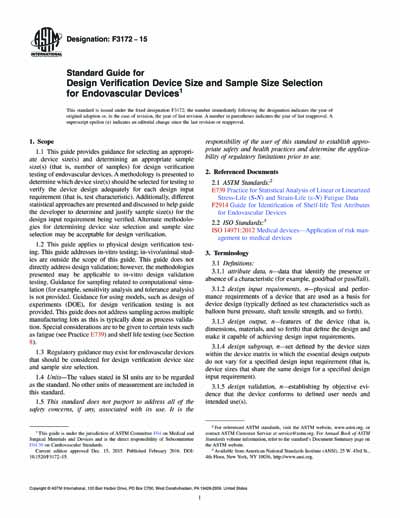Historical
ASTM F3172-15
Standard Guide for Design Verification Device Size and Sample Size Selection for Endovascular Devices
1.1 This guide provides guidance for selecting an appropriate device size(s) and determining an appropriate sample size(s) (that is, number of samples) for design verification testing of endovascular devices. A methodology is presented to determine which device size(s) should be selected for testing to verify the device design adequately for each design input requirement (that is, test characteristic). Additionally, different statistical approaches are presented and discussed to help guide the developer to determine and justify sample size(s) for the design input requirement being verified. Alternate methodologies for determining device size selection and sample size selection may be acceptable for design verification.
1.2 This guide applies to physical design verification testing. This guide addresses in-vitro testing; in-vivo/animal studies are outside the scope of this guide. This guide does not directly address design validation; however, the methodologies presented may be applicable to in-vitro design validation testing. Guidance for sampling related to computational simulation (for example, sensitivity analysis and tolerance analysis) is not provided. Guidance for using models, such as design of experiments (DOE), for design verification testing is not provided. This guide does not address sampling across multiple manufacturing lots as this is typically done as process validation. Special considerations are to be given to certain tests such as fatigue (see Practice E739) and shelf life testing (see Section 8).
1.3 Regulatory guidance may exist for endovascular devices that should be considered for design verification device size and sample size selection.
1.4 Units—The values stated in SI units are to be regarded as the standard. No other units of measurement are included in this standard.
1.5 This standard does not purport to address all of the safety concerns, if any, associated with its use. It is the responsibility of the user of this standard to establish appropriate safety and health practices and determine the applicability of regulatory limitations prior to use.
Content Provider
ASTM International [astm]






